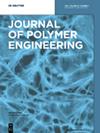Preparation and evaluation of polyvinyl alcohol hydrogels with zinc oxide nanoparticles as a drug controlled release agent for a hydrophilic drug
IF 1.7
4区 工程技术
Q4 POLYMER SCIENCE
引用次数: 0
Abstract
Abstract We report the preparation and application of ZnO/PVA nanocomposite hydrogel containing diclofenac sodium drug (DS) as a drug delivery system. The purpose of designing the nanocomposite hydrogels is to reduce the frequency of use and its side effects, and increase the effect of the drug. The desired nanocomposite hydrogel were prepared through the freezing–melting cycle. The structure and morphology were determined by FTIR and SEM, respectively. The gel fraction increased with adding the nanoparticles, from 67.49 % to 97.69 %. This amount also reaches 97.97 % by adding the drug. The degree of swelling decreased with increasing the amounts of nanoparticles and DS (998 % for PVA-710 % for 1 wt% DS). Based on the result of antibacterial properties and biocompatibility, the inhibition zones around the sample were about 2 mm for Staphylococcus aureus and for Escherichia coli. The cell viability of hydrogel increased from 66.02 % to 79.84 % with increasing the amount of DS. The biodegradation of PVA, is also higher (5–27.17 %) than ZnO/PVA with (3.8–20.2 %) and without (4–23.53 %) drug. The modeling results showed that Peppas–Korsmeyer is a good model for DS release from ZnO/PVA and the diffusion mechanism of DS is Fickian. In this way, we introduced an effective system for drug delivery.氧化锌纳米粒子作为亲水性药物控释剂的聚乙烯醇水凝胶的制备与评价
摘要:本文报道了双氯芬酸钠药物(DS)纳米复合水凝胶的制备及其应用。设计纳米复合水凝胶的目的是为了减少药物的使用频率和副作用,提高药物的效果。通过冻融循环法制备所需的纳米复合水凝胶。通过FTIR和SEM对其结构和形貌进行了表征。随着纳米颗粒的加入,凝胶分数从67.49 %增加到97.69 %。加入该药物后,该含量也达到97.97 %。随着纳米颗粒和DS用量的增加,肿胀程度降低(PVA-710 = 998 %,DS = 1 wt%, %)。根据抗菌性能和生物相容性的结果,样品对金黄色葡萄球菌和大肠杆菌的抑制带约为2 mm。随着DS用量的增加,水凝胶细胞存活率由66.02 %提高到79.84 %。PVA的生物降解率(5-27.17 %)也高于添加(3.8-20.2 %)和未添加(4-23.53 %)药物的ZnO/PVA。模拟结果表明,Peppas-Korsmeyer模型是一个较好的DS从ZnO/PVA中释放的模型,DS的扩散机制为Fickian。通过这种方式,我们引入了一种有效的给药系统。
本文章由计算机程序翻译,如有差异,请以英文原文为准。
求助全文
约1分钟内获得全文
求助全文
来源期刊

Journal of Polymer Engineering
工程技术-高分子科学
CiteScore
3.20
自引率
5.00%
发文量
95
审稿时长
2.5 months
期刊介绍:
Journal of Polymer Engineering publishes reviews, original basic and applied research contributions as well as recent technological developments in polymer engineering. Polymer engineering is a strongly interdisciplinary field and papers published by the journal may span areas such as polymer physics, polymer processing and engineering of polymer-based materials and their applications. The editors and the publisher are committed to high quality standards and rapid handling of the peer review and publication processes.
 求助内容:
求助内容: 应助结果提醒方式:
应助结果提醒方式:


